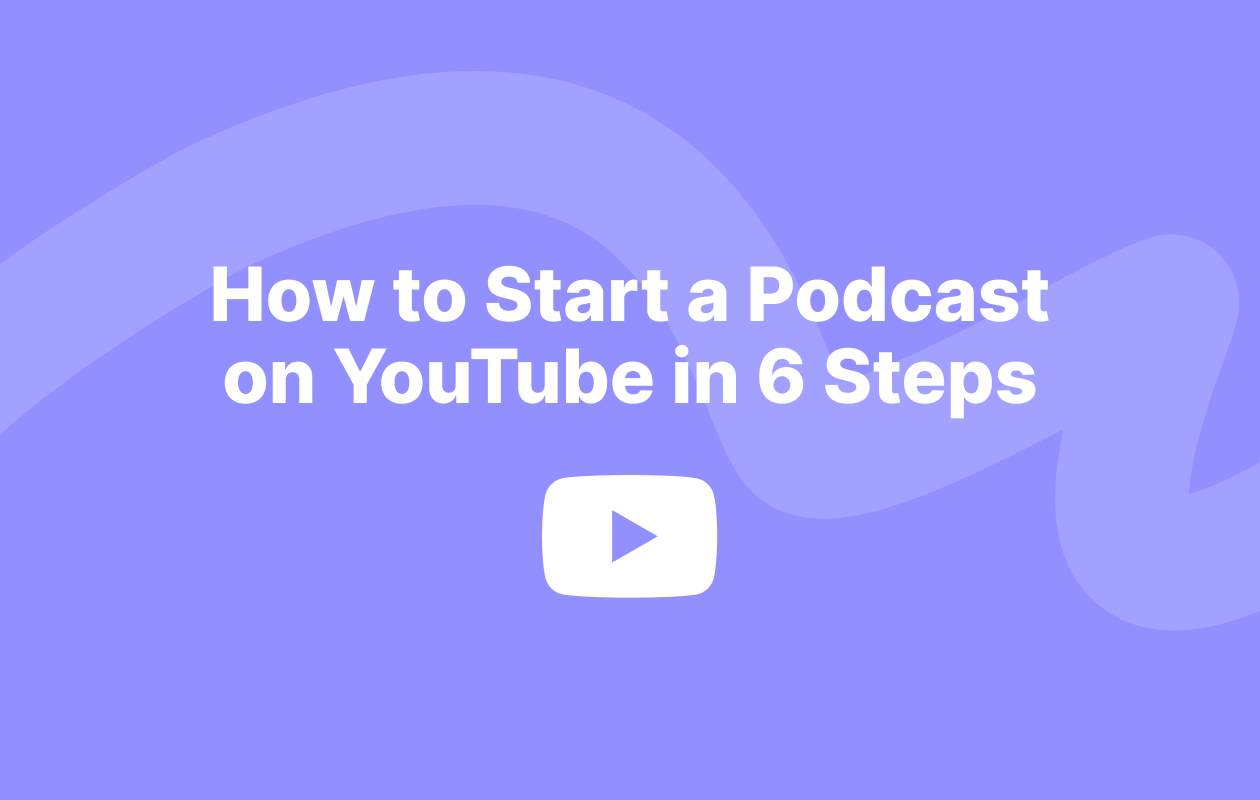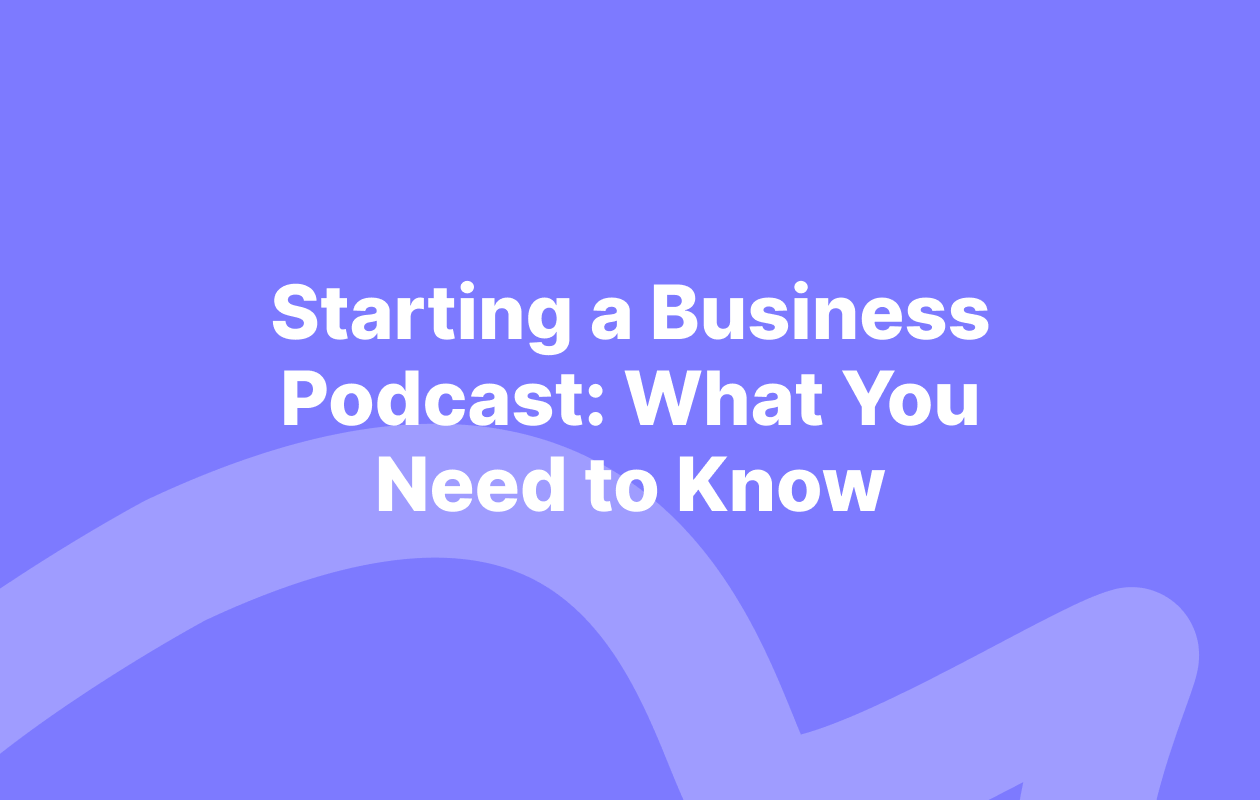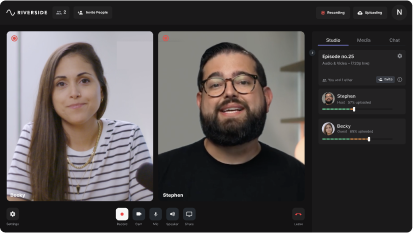Last Updated
June 27, 2023
How to Start a Podcast For Free: 10 Easy Steps (2023)
.webp)
You can start a podcast for free, trust us.
There’s a common misconception that podcasting is expensive or that you’ll have to invest a lot up front to get yourself setup. But in actual fact, starting a podcast for free is not that unusual or difficult. And no, creating a podcast for free does not necessarily mean sacrificing quality.
In this guide, we’re walking you through how to start a podcast for free in 10 steps (no strings attached).
TL;DR
- Starting a podcast for free is not only possible, it’s easy.
- To get started, you’ll need a phone/laptop, podcast recording tool and a podcast host.
- Riverside is a powerful free podcast recording tool that makes it easy to create studio-quality podcasts
- You can record and launch your podcast for free in just 10 steps.
How much does it cost to start a podcast?
In all honesty, a podcast can cost as much or as little as you want or need it to. As the title of this article suggests, it is entirely possible to start a podcast for free. So even if you don’t have anything to spare towards getting your podcast up and running, don’t worry - it’s doable without even spending a cent.
Can you create a podcast for free?
Before we get to our practical tips, we want to do some myth-busting. It’s absolutely possible to start a podcast for free. Obviously, creating a podcast for free means you won’t be kitting yourself out with the newest equipment or subscribing to expensive tools and services, but that doesn’t mean sacrificing on quality.
What is required to start a podcast for free?
Luckily starting a podcast for free involves a mix of working with what you already have and harnessing a few free tools. You’ll have a full podcasting setup in no time:
An idea
You can’t start a podcast without an idea and a plan. You need to have a vision for what your podcast is going to be about, how you’re going to format it, and what you’re going to record. Preparation, consistency and passion are key - if you can tick these three boxes, you’re basically set.
Mobile Phone/Computer
You’ll need either a mobile phone, laptop or desktop in order to record, produce and publish your podcast.
Mic
If you’re starting from scratch, chances are you don’t have an external mic lying around. Don’t worry - you can use your phone or computer’s in-built microphone, although keep in mind that this may result in lower quality recordings in the long-run.
Camera
If you’re looking to create a video podcast, you can use your computer’s in-built camera or the webcam you use for work. You could also use your phone’s camera. This is often the better option because some phones like iPhones shoot in 4k quality.
Podcasting recording software
A podcast recording tool is absolutely essential. This is key to capturing your audio and potentially including remote guests in your recording. Luckily there are a number of free and affordable paid tools out there like Riverside and Garageband, for example.
Want to see how easy it is to start recording a podcast for free? Start recording with Riverside.
Free podcast host
Last but not least, you’ll need a free podcast host. A podcast host stores and distributes your podcast episodes. There are a variety of free podcast hosts such as Anchor that also give you key insights into your podcast’s performance and help you to monetize your content.
How to Start a Podcast for Free: 10 Steps
Now that you’ve got your podcasting setup ready to go, follow these 10 steps to get started.
Step 1: Plan your podcast
Before you jump to recording your inaugural episode, you’ve got to dedicate some time to planning and ideation. Though this might sound boring or even unnecessary, planning can take a lot of stress out of the process in the long-run. And since the only thing you need is your creativity and brain power - there’s nothing to lose!
At this stage, you should try to refine your podcast identity, plan out some episodes (however roughly) and, if you’re going to be recording with remote guests, aligning your calendars.
Step 2: Find a recording space in your home
Next you’ll need to identify a suitable recording space. Don’t worry, you don’t need a fully sound-treated studio to record high-quality audio. However, it is worth taking the time to find the most ideal space you have access to since this will maximize your chances of recording flawless audio.
If you want some tips, check out our guide to building a home studio.
Step 3 : Sign up for your free podcast recording tool & host
Next, you’ll need to sign up and create an account with your chosen podcast recording tool and podcast host. Signing up to a recording tool like Riverside is super easy. But your podcast host is likely to require some information about your podcast such as its name, description, and cover art. So make sure to have these on hand.
Step 4: Setup your equipment
Next, you’ll want to get yourself ready to record. Even if your setup is fairly stripped back and straightforward, it’s important to make sure that everything works and interacts properly. You may also want to take the time to familiarize yourself with your recording tool’s features, for example.
Read more: Best Podcast Equipment for Beginners & Pros on a $100 Budget
Step 5: Record your first episode
When you’re all set up and ready to go, it’s time for the exciting part: recording your first episode. Sit back, relax, and enjoy the process.
Read more: How to Record a Podcast like a Pro (The Easy Way)
Step 6: Edit your recording
When you’re finished with your recording session, you’ll need to get your raw recording ready for publication. This doesn’t necessarily mean granular intervention - though it can if you want it to. You can choose to use integrated tools like Riverside’s editor to get your podcast publication ready quickly. Or choose to use a free editing tool to take your time during podcast post-production.
Step 7: Upload to your podcast host & distribute
When your podcast is ready to go, you’ll need to upload your recording to your podcast host for distribution. You may need to provide additional information or fill out distribution forms for specific listening platforms if you haven’t done so already. Some hosts do this automatically for you.
Step 8: Promote your podcast episode
Once your podcast is live, you’ll need to do some work to promote it. This means reaching out to your network and asking them to share the new episode with their friends. You should also be proactive on your podcast’s social media.
Read more: Podcast Marketing: 20 Proven Strategies for Podcast Promotion
Step 9: Monetize your content
Though this isn’t a necessary step, you can also choose to monetize your content to start making money from your podcast. Your podcast host might offer integrated monetization features such as dynamic advertising or subscriptions, but you can also set up a third-party patreon account to start accepting donations from your listeners.
Learn more: How to Make Money Podcasting in 2023: 12 Effective Ways
Step 10: Repeat
When you’ve got this process down, it’s just a matter of repeating this workflow with consistency. Which just goes to show, you don’t need an extensive or big budget to get started (or be successful) podcasting.
Watch the video below, for a visual step-by-step through the process of starting a podcast for free:
Starting a Podcast for Free with Riverside
Now that we’ve seen a broad overview of the 10 steps to starting a podcast for free, let’s dive into detail and look at how to podcast with Riverside. First though, let’s take a brief look at Riverside’s key features (all available for free):
- Local recording. Your podcast is always recorded directly on yours your your participants’ devices, rather than over the internet. This means that your recording resolution won’t be affected by internet connection.
- Remote guests. Include up to 7 remote guests in your recording.
- Text-based Video and Audio Editor. Integrated editor that helps you to get your podcast publication ready in no time.
- Livestream to major platforms as a different way to include your audience in your recording process.
- Browser-based or mobile app. Record on the go from your laptop or mobile phone wherever you find yourself.
- Automatic transcriptions. Make your content as accessible and repurposable as it should be with Riverside’s automatic transcription feature.
How to podcast with Riverside for free
Step 1: Create a free account.
Sign up for a free account with Riverside. For the best results and experience, use Google Chrome.
Step 2: Create your podcast in Riverside.
From your dashboard, click ‘+New studio’ and give it a name. Choose whether you want it to be an ‘Audio & Video’ podcast or just ‘Audio Only’. When you’re happy, click ‘Enter studio’.

Alternatively, if you’re setting your studio up in advance, you can click ‘Continue set up studio’. Here you’ll be able to schedule and invite remote guests ahead of time.
Step 3: Check everything is good to go in the Lobby
From there, you’ll end up in your ‘Lobby’ where you can check everything is working properly and touch-up your appearance. This is also the point at which you can check that any equipment you have hooked up to your computer is properly recognized by Riverside. When you’re happy, click ‘Join Studio’.
.webp)
Step 4: Invite your remote guests
Once you’re in the recording studio, click the 'copy link’ button to invite your participants. You can also email them the invite link.

Step 5: Start recording.
When everyone is ready, hit the red Record button to start your session. You’ll find this at the bottom of your screen. Each participant’s local recording will progressively upload throughout your session.
.webp)
When you’re finished recording, make sure to remind your guests not to close their browser window until their file has fully processed. This is to ensure your recording uploads properly.
Step 6: Retrieve your recording.
Once your session is over, you can go retrieve your recording. Click ‘view all recordings’ and you’ll find your files. From here, you can download your audio recording as is, or choose to head straight to the Editor to get it ready for publication.
Step 7: Use the editor to get your podcast ready.

Click the purple ‘Edit and create clips’ button in the top right of your screen and you’ll end up in Riverside’s integrated editor tool. Here you can trim and cut your recording and customize your content, before exporting for publication.
With Riverside you can edit your podcasts as easily as editing a text transcript. Our Ai transcriptions come in over 100 languages and you can easily use them to navigate and edit your recordings. Any text you delete in the transcript automatically removes the matching video and audio in your podcast recording. The editor also has tools for customizing your layout and appearance, plus automatically fine-tuning your audio.
FAQs on How to Start a Podcast for Free
Can just anyone start a podcast for free?
Absolutely, anyone and everyone can start a podcast for free. That’s the beauty of the medium - there is a super low barrier to entry. Equipped with just a mobile phone or laptop, recording software and podcast host, you can make waves in the podcasting world.
Do podcasters make money?
Podcasters who choose to monetize their content can make serious returns on their work. Bear in mind, though, that in order to make money podcasting you’ll need to either cultivate a loyal fanbase that will subscribe for your content or secure a sponsorship or advertising deal based on your podcast’s performance and reach.
How long does it take to make money from a podcast?
There’s no set timeline for how long it will take for your podcast to make money. This depends on a number of factors such as audience numbers, how well known you are, whether your niche and show appeals to potential advertisers and sponsors.
Where can I create a free podcast?
As we’ve seen, you can use Riverside to create a free high-quality podcast. You can then distribute and publish (via your podcast host) to all the major listening platforms for free.
Is creating a Spotify podcast free?
Yes, you can create a Spotify podcast for free. There are no fees associated with publishing your podcast to Spotify. If you’re creating a video podcast, you can do so on Riverside and seamlessly distribute it to Spotify with our Anchor integration.















.jpg)


 (1).webp)
.webp)
.webp)








